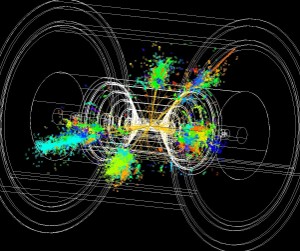 |
 |
|||||||||||||
|
|||||||||||||
|
|||||||||||||
|
The new group for linear collider detector development at CERN is less than a year old, but it is growing fast: a number of students and fellows are already working on simulations, and as of next year there will be funds for actual hardware development. The linear collider detector R&D group (LCD) is led by Lucie Linssen. As a group based at CERN, home of the Compact Linear Collider study CLIC, its main focus is on detectors that record the collisions that CLIC would produce. At three TeV these have a much higher energy than the 500-GeV collisions at the ILC, higher backgrounds and very different timing: whereas there are 340 nanoseconds between two particles bunches colliding in the ILC, at CLIC the plan is to have electron-positron collisions every half a nanosecond.
The focus on CLIC physics, however, does not mean that there is no overlap with R&D projects done around the world for future ILC detectors. Simulations for CLIC detectors use the same software tools and are based on existing simulations made for ILD and SiD, and CERN is an official member of the CALICE collaboration and the FCAL and LCTPC groups. “We are one community and want to exploit all possible synergies – there is no need to reinvent the wheel,” says Lucie Linssen, a particle physicist who has been technical coordinator for a number of experiments during her physics career. The group is also involved in developing precise readout electronics for tracking detectors, working on solenoid coil studies and fast readout features for all detector components. "Timestamping" – the possibility to attach a precise point of time to a precise particle location – is a must for a future CLIC detector, and the ILC detectors will benefit from the technology, too. Once more substantial funding is available from next year on, the group will be able to expand more and tackle their first proper hardware projects. One of the projects that the physicists are very excited (and slightly anxious) about, however, is a plan to build a hadron calorimeter using tungsten as absorber material. A calorimeter measures the energy of passing particles, and in order to do that it needs to make them interact first. That is why a calorimeter consists of several different layer sandwiches: a very dense absorber material (for example steel, as in the ILD and SiD hadronic calorimeters) followed by the 'detector layer' that records the passing particles from the particle shower produced when one particle hits the absorber layer and knocks out secondary particles from the material. Tungsten, which is much denser than steel, would do this job well. But it is also notoriously hard to work with and building a hadron calorimeter with it is a first. “If it works, it is a real physics benefit because the new material enhances our physics output enormously,” says Felix Sefkow, spokesman of the CALICE collaboration. “I am very happy that we are working together on this – the results will be interesting for the whole calorimeter community.” Discussions started two weeks ago on how the CERN LCD group could use the movable stage built for calorimeter testbeams. It will first use the existing scintillator layers that have been probed thoroughly in previous beam tests; but other technologies for the active layers are also foreseen – stay tuned for reports on its progress. -- Barbara Warmbein |
|||||||||||||
| © International Linear Collider |
